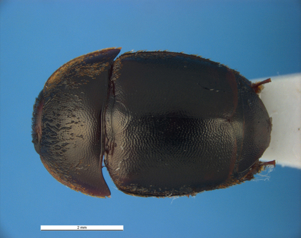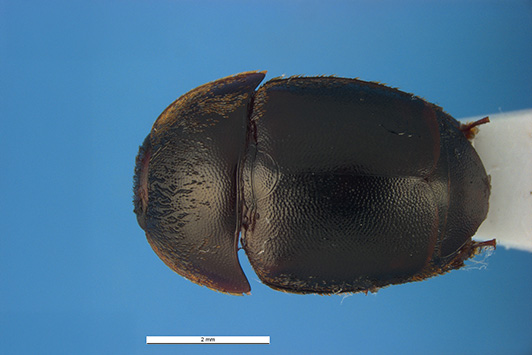Look and report
Small hive beetle is a declared pest in Western Australia.
Small hive beetle (SHB) (Aethina tumida) is a tiny pest that poses a significant threat to honey bee colonies. These dark brown or black beetles burrow into combs consuming brood, honey and pollen. The larvae carry a yeast which leads to the fermentation and spoilage of honey.
This pest is currently found in Western Australia’s (WA) Kimberley region. The rest of the state is free from this pest.
Small hive beetle is native to South Africa and may also occur in subtropical and tropical parts of Africa.
It has been found in 17 widespread locations throughout the USA and may also inhabit other temperate areas. The adults are broad, flattened beetles, about 5–7 millimetres long, and are dark brown to nearly black.
The larvae are elongated, whitish grubs, which can be seen to have rows of spines on the back when viewed under magnification.
Adults and larvae inhabit bee hives where they feed on stored pollen and honey. The burrowing beetles damage combs and kill the brood. As the infestation grows, the honey ferments and bubbles out of the cells, smelling like decaying oranges.
Honey supers removed and stored by the beekeepers can also be infested during storage, prior to the honey being extracted.
Bees abandon heavily infested hives but the larvae continue to feed on the honey. The larvae pupate in the ground and this makes control of the small hive beetle difficult. Feral bee colonies can also become infested. Control measures have so far been unsuccessful.
The beetles can feed and develop normally and complete all life cycle stages on fruit such as avocado, cantaloupe (melon or cucurbit family) and grapefruit. The beetle also feeds on bananas, pineapple, grapes and mango. Used equipment or comb honey could spread the pest.

Small hive beetle poses a serious threat to honey bee colonies by damaging combs and causing honey to ferment and spoil. The stress from small hive beetle can weaken the bees, sometimes leading to colony abandonment. In severe cases, heavy infestations can result in the complete collapse of the colony. Effective monitoring and management of small hive beetle are essential to protect and maintain healthy bee colonies.
Signs of small hive beetle include:
- numerous larvae burrowing and tunnelling in brood and honeycomb cells
- adult beetles may not be easily observed
- honey weeping from comb where cell walls and caps have been pierced by the activities of the larvae
- darkened honey due to contamination of faeces deposited by the larvae
- fermentation and frothing of honey in hives or in combs of honey stored in honey houses with an odour similar to decaying oranges are typical signs of infestation. Fermented honey may drip and collect on the hive bottom board or the honey house floor
- trails of fermented honey left on the floor by larvae that crawl from stored honey super boxes as they try to reach the soil to pupate
- when a hive is opened, the adult beetles usually run quickly from the combs and hide in the darker areas, especially the rear of the bottom board.
Beekeepers should regularly check hives for the presence of small hive beetle. The following steps should be undertaken:
- Remove the lid and place it on the ground upside down. Place the super box on top of the lid and leave it for about a minute. Lift the super off the lid and look for the beetles. Beetles will move quickly away from the light when the hive lid is opened.
- If no beetles are seen, remove brood combs one at a time, examine all surfaces and place each frame outside the hive. Continue until all frames have been examined and the brood chamber is empty.
- Examine the floor of the brood chamber, looking at the back or rear corners of the bottom board where the beetles hide from the light.
- If the bottom is not attached, remove the brood chamber and examine the bottom board. The beetles will tend to move quickly from the light.
- Beetles can be picked up using fine-tipped tweezers or your fingers. Place them in a sealed container until dead.
- Check the super boxes and frames for infested larvae, particularly those that have been removed for extraction.
- Adult beetles can be found in debris surrounding the hive floor or in dark areas.
- During cooler temperatures beetles can be found in the honey bee clusters.
The primary damage caused to colonies and stored honey is through the feeding activity of the larvae. Hives and stored equipment with heavy infestations of beetles have been described as a mess.
A summary from reports of damage caused by these beetles shows:
- Larvae tunnel through comb with stored honey or pollen, damaging or destroying capping and comb.
- Larvae defaecate in honey which becomes discoloured.
- Activity of the larvae causes fermentation and froth in the honey. This develops a characteristic odour of decaying oranges.
- Damage and fermentation causes honey to run out of combs, creating a mess in hives or extracting rooms.
- Heavy infestations lead to bees abandoning their hive which may cause a rapid collapse of even strong colonies.
- Largest infestations are normally found in and near honey houses.
- Colonies can quickly collapse after beekeepers have united them with other highly infested supers.
Small hive beetle spread in 2 main ways.
Natural spread
- SHB are strong flyers, travelling up to 15 km to find new hives
- they are attracted to the odour that new hives and colonies produce
- feral honey bee colonies have also been known to spread SHB.
Human-assisted spread
- moving infected hives
- transporting hive products like: comb, bee collected pollen, slum-gum, beeswax cappings and scraps which have not been melted down
- movement of stored combs and supers, that may appear to be clean.
Legal duty to report
Aethina tumida is a declared pest in WA. It is a prohibited organism under section 12 of the Biosecurity and Agriculture Management Act 2007.
This means that any person who finds or suspects the presence of Small Hive Beetle outside of the Kimberley region must report it to DPIRD.
Reporting is not just a legal obligation; it's crucial for safeguarding your hives and nearby colonies. Early detection gives us the best chance to eradicate pests and diseases. By following best practices and reporting promptly, we can protect Western Australia’s healthy bee populations and stop the spread of harmful pests and diseases.
Make a reportMovement Restrictions for bees, hive products and/or beekeeping equipment within Western Australia
To prevent the spread of small hive beetle within WA, the movement of commercial honey, bees, apiary products and beekeeping equipment from the Kimberley region to other areas of the state, which are free of small hive beetle, is subject to strict quarantine conditions.
To prevent the spread of small hive beetle within WA, conditions must be met to prevent the introduction of small hive beetle to areas where this pest is absent.
A permit is required before moving honey, bees, apiary products and beekeeping equipment from the Kimberley region of WA (Local Government Areas of Broome, Derby-West Kimberley, Wyndham-East Kimberley and Halls Creek) to all other Local Government Areas in WA.
Importers must apply for a permit to move the above.
A permit application must:
- be submitted to the Department of Primary Industries and Regional Development (DPIRD) using the approved form
- include all required information
- be accompanied by the appropriate application lodgement fee.
The completed application form to be submitted via pbpermit@dpird.wa.gov.au.
DPIRD will aim to assess applications within 10 working days pending information availability and complexity of the application.
Application for permit to move a potential carrier into small hive beetle free area of WASearch Western Australian Organism List
The Western Australian Organism List (WAOL) provides the status of organisms which have been categorised under the Biosecurity and Agricultural Management Act 2007.
Western Australian Organism List
